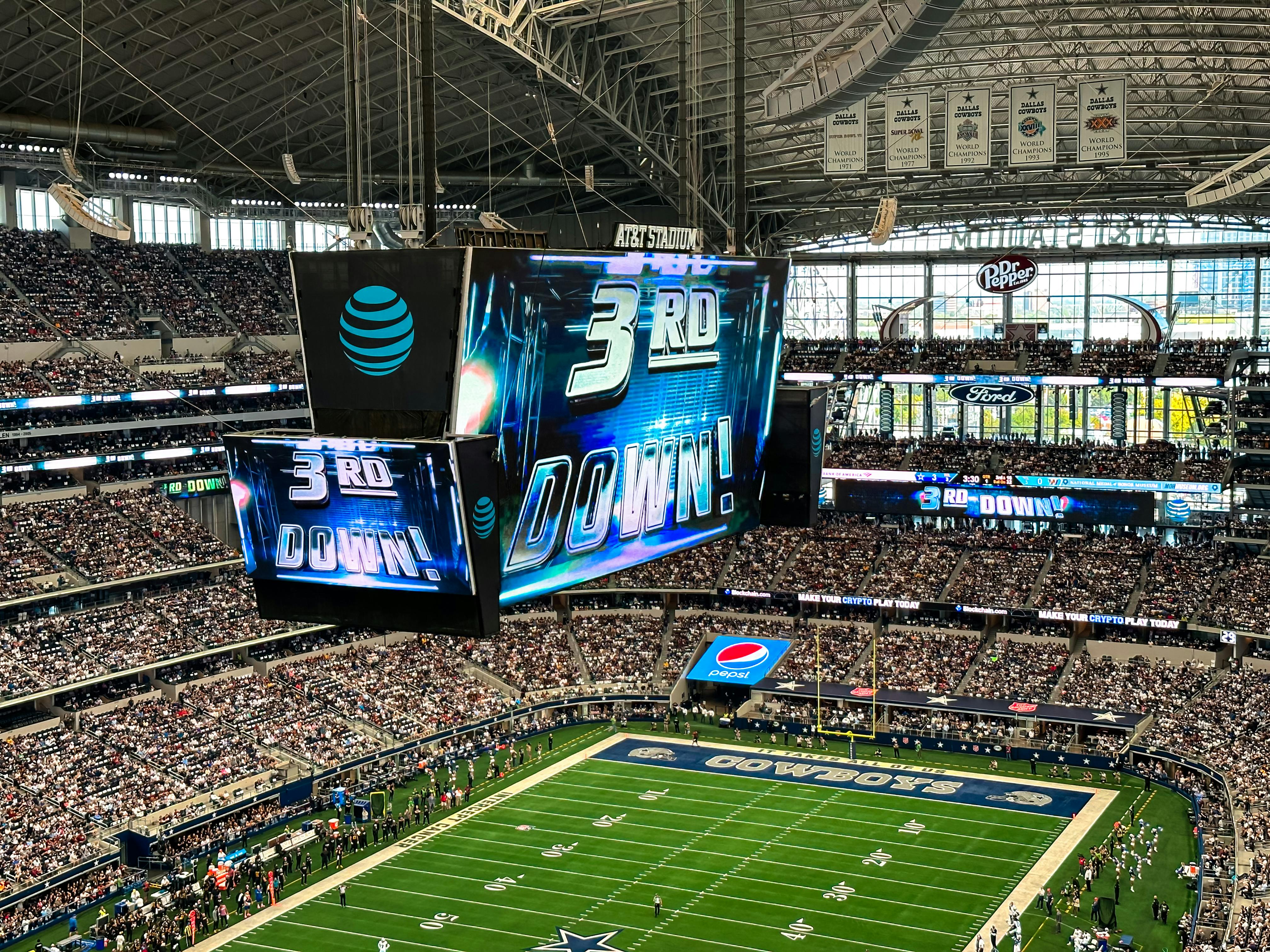Unpacking Dallas Cowboys 2025 NFL Trade Deadline Grades
TL;DR (Quick Answer)
The 2025 NFL trade deadline ignited a league-wide spree of player movement, driven by aggressive playoff pushes and strategic rebuilds. Teams, including the Dallas Cowboys, made bold moves, reshuffling rosters and setting the stage for an unpredictable season finish.
Introduction
Ever felt that electrifying buzz as the clock ticks down, knowing that monumental decisions are being made that could completely reshape a team's destiny? That's precisely the kind of adrenaline-fueled excitement that engulfed the NFL as the 2025 NFL trade deadline approached, and then exploded into a full-blown frenzy. It was a day, or rather, a week, that had fans glued to their screens, refreshing news feeds, and debating every potential blockbuster deal. Why such a whirlwind of activity this year, you ask? Well, gather 'round, because we're about to dive deep into the fascinating dynamics that made this particular deadline unforgettable. We'll explore the strategic chess matches, the surprising player movements, and even put on our general manager hats to grade the Dallas Cowboys' maneuvers.

What is the NFL Trade Deadline?
So, what exactly *is* the NFL trade deadline? In simple terms, it's a specific date and time during the NFL season when teams are no longer allowed to make trades with one another. Think of it like a strict closing time for a bustling marketplace. Before this deadline, general managers are like shoppers, meticulously browsing, negotiating, and trying to find that perfect piece to complete their puzzle. After it passes, the doors are shut, and teams have to go with the roster they've assembled for the rest of the regular season and playoffs.
Typically falling around Week 8 or 9 of the regular season, the trade deadline serves as a pivotal moment for every team in the league. For some, it's a last-ditch effort to acquire a superstar talent or a missing puzzle piece that could propel them into serious Super Bowl contention. These are the 'buyers.' They're willing to part with future draft picks or promising young players in exchange for immediate impact. For others, particularly those struggling through a tough season, it's an opportunity to shed high-salaried veterans, gather future draft capital, and essentially 'sell off' assets to kickstart a rebuild. These are the 'sellers.' And then there are the teams caught in the middle, the 'fence-sitters,' who might make minor adjustments or stand pat, hoping their current roster is good enough.
The deadline creates a fascinating blend of desperation, calculated risk, and strategic foresight. It’s not just about player swaps; it's about salary cap implications, locker room chemistry, and the long-term vision of a franchise. Every trade, or lack thereof, sends ripples throughout the league, impacting standings, playoff races, and even coaching tenures. It’s a high-stakes poker game played out on a national stage, and the 2025 version was one for the history books.
Why was the 2025 NFL Trade Deadline a Frenzy of Activity?
The 2025 NFL trade deadline wasn't just active; it was an absolute whirlwind, a veritable maelstrom of player movement that left analysts and fans alike breathless. But why such an unprecedented frenzy? Several converging factors created the perfect storm for a trade bonanza:
1. Unprecedented Parity Across the League
Heading into the deadline, the NFL felt more wide-open than ever. There wasn't a single dominant juggernaut steamrolling the competition. Instead, multiple teams in both conferences saw themselves as legitimate contenders, just a piece or two away from Super Bowl glory. This perception fueled an aggressive 'buyer's market.' Teams felt that if they didn't make a move, a rival certainly would, potentially gaining an edge in a tightly contested playoff race. It was a classic case of FOMO – Fear Of Missing Out – but on a grand, multi-billion-dollar scale.
2. A Strong Draft Class on the Horizon
On the flip side, many struggling teams knew they weren't going to compete this year. However, they also had their eyes on the horizon, specifically the highly touted 2026 NFL Draft class, which was brimming with potential franchise-altering talent. This made them eager 'sellers.' They were more than willing to part with veteran players on expiring contracts or those who didn't fit their long-term plans, knowing they could restock their cupboards with high-value draft picks. This perfect alignment of aggressive buyers and willing sellers created fertile ground for trades.
3. Flexible Salary Cap Situations
Unlike some previous years, many teams found themselves with relatively healthy salary cap space, thanks to shrewd financial management and a rising cap ceiling. This financial flexibility was like having extra chips at the poker table. It allowed general managers to absorb more significant contracts, making bigger, more impactful trades feasible without crippling their future financial outlook. Suddenly, acquiring that high-priced receiver or dominant defensive end wasn't just a pipe dream; it was a tangible possibility.
4. Increased Emphasis on Mid-Season Adjustments
Modern NFL analytics and coaching philosophies increasingly emphasize the importance of mid-season adjustments. Teams are quicker to identify weaknesses or areas where they can upgrade. Gone are the days of simply 'sticking with what you've got.' The understanding that one impactful trade can galvanize a locker room, boost a struggling unit, or provide a critical edge against rivals has never been stronger. General managers are empowered (and expected) to be proactive, not reactive, when opportunities arise.
5. Social Media and Media Scrutiny
Let's be honest, the constant hum of social media and 24/7 sports coverage adds another layer of pressure. Fans, pundits, and AI-driven news algorithms dissect every rumor and every potential move. This intense scrutiny, while not directly causing trades, certainly amplifies the urgency and conversation around the deadline. GMs know their every move (or non-move) will be scrutinized, sometimes pushing them to act decisively. It's a digital echo chamber that makes the 'frenzy' feel even more intense.
Combine these elements, and you get a melting pot of strategic necessity, financial opportunity, and competitive pressure. The 2025 NFL trade deadline wasn't just a series of transactions; it was a reflection of a league in constant motion, always striving for that elusive competitive advantage.
Top Trades of the 2025 NFL Trade Deadline
The 2025 NFL trade deadline delivered on its promise of drama, with several high-profile deals sending shockwaves across the league. Let's break down some of the most impactful moves:
- Blockbuster Wide Receiver Swap: Titans acquire WR 'Speedy' Johnson from Falcons – In arguably the biggest splash, the Tennessee Titans, desperately needing a game-breaking receiver to complement their strong run game, sent a 2026 first-round pick and a 2027 third-round pick to the Atlanta Falcons for three-time Pro Bowl wideout, 'Speedy' Johnson. Johnson, a true deep threat, was unhappy in Atlanta, and the Falcons, despite being in the playoff hunt, decided to cash in on his immense value. The Titans immediately became a more potent offensive force, while the Falcons stockpiled future assets.
- Defensive Anchor Shifts: Chiefs land DE 'Sack Master' Williams from Commanders – The Kansas City Chiefs, already Super Bowl contenders, decided to go all-in, acquiring elite pass rusher 'Sack Master' Williams from the Washington Commanders for a 2026 second-round pick and a 2027 fourth-round pick. Williams, known for his relentless motor and ability to disrupt opposing offenses, instantly elevated the Chiefs' formidable defense. The Commanders, clearly rebuilding, continued to gather draft capital, recognizing Williams's expiring contract made him a prime trade candidate.
- Quarterback for the Future: Raiders trade for QB 'Cannon Arm' Smith from Giants – In a move that signaled a shift for both franchises, the Las Vegas Raiders sent their starting quarterback, a 2026 third-round pick, and a conditional 2027 fifth-round pick to the New York Giants for promising young quarterback 'Cannon Arm' Smith. Smith had shown flashes of brilliance but struggled for consistency in New York. The Raiders believe their coaching staff can unlock his full potential, investing in a long-term solution at the most critical position. The Giants, on the other hand, got a proven veteran to stabilize their immediate future while gaining valuable draft capital.
- Veteran Presence for Depth: Eagles acquire LB 'Field General' Davis from Bears – The Philadelphia Eagles, always looking to bolster their roster, made a quieter but crucial move, acquiring veteran linebacker 'Field General' Davis from the Chicago Bears for a 2026 sixth-round pick. Davis, a savvy run-stopper and locker room leader, provided much-needed depth and experience to the Eagles' defense, especially against physical NFC opponents. The Bears, looking to give younger players more reps, were happy to recoup some draft capital for a player who likely wouldn't be part of their long-term plans.
- Offensive Line Reinforcement: Bills trade for OT 'Brick Wall' Miller from Texans – The Buffalo Bills, aiming to protect their star quarterback and boost their run game for a deep playoff push, sent a 2026 fourth-round pick to the Houston Texans for veteran offensive tackle 'Brick Wall' Miller. Miller brought stability and power to the Bills' offensive line, providing an immediate upgrade in pass protection and run blocking. The Texans, not expecting to compete this year, leveraged Miller's solid performance into a mid-round pick.
These trades weren't just about moving players; they were about teams declaring their intentions. The buyers went for it, the sellers prepared for the future, and the league as a whole became infinitely more interesting.
Comparison Table: Buyer vs. Seller Mentality at the Deadline
Understanding the 2025 NFL trade deadline frenzy requires recognizing the fundamental philosophies driving teams. It's often a stark contrast between those looking to acquire and those looking to divest. Let's compare the 'Buyer' and 'Seller' mentalities:
This dichotomy is what makes the trade deadline so compelling. Both approaches are valid, depending on a team's current situation and long-term vision. The 2025 deadline saw an abundance of both mindsets, creating a truly dynamic trading environment.

Dallas Cowboys' 2025 NFL Trade Deadline Grades
Ah, the Dallas Cowboys. America's Team, always under the microscope, especially during a frenzied event like the 2025 NFL trade deadline. This year, they were certainly players, making a couple of moves that drew immediate reactions. Let's break down what they did and assign some hypothetical grades:
Cowboys' Trade 1: Acquire TE 'Sure Hands' Clark from Cardinals
- Details: The Cowboys sent a 2026 fourth-round pick to the Arizona Cardinals for veteran tight end 'Sure Hands' Clark. Clark, 30, was a reliable pass-catcher and solid blocker, but was on an expiring deal with the rebuilding Cardinals. The Cowboys, struggling with inconsistent production from their tight end group, saw Clark as an immediate upgrade.
- Analysis: This was a classic 'win-now' move for the Cowboys. They needed a dependable target for their quarterback, especially in the red zone and on crucial third downs. Clark provides that veteran presence and consistent production. Giving up a mid-round pick for a rental player is always a gamble, but if it helps them win a playoff game, it's worth it. He fills an immediate need without breaking the bank or mortgaging too much of the future.
- Grade: B+ – A solid, sensible move that addresses a clear need. Not a blockbuster, but a smart, calculated acquisition.
Cowboys' Trade 2: Trade CB 'Lockdown' Jones to Browns
- Details: The Cowboys traded cornerback 'Lockdown' Jones, a former Pro Bowler who had fallen out of favor and was seeing reduced snaps, to the Cleveland Browns for a 2026 conditional sixth-round pick (could become a fifth if Browns make playoffs). Jones was in the final year of a significant contract, and the Cowboys had younger corners they wanted to develop.
- Analysis: This was a pragmatic move. Jones, while talented, wasn't a perfect fit in the current defensive scheme and his contract was becoming a burden given his reduced role. Clearing his salary off the books and getting *any* draft capital for a player who might have walked in free agency anyway is a win. It also opens up opportunities for younger players to step up and gain valuable experience. It’s not exciting, but it's good team management.
- Grade: C+ – A necessary housekeeping move. They didn't get a huge return, but they cleared cap space and got something for a depreciating asset. It feels more like damage control than a strategic triumph.
Overall Dallas Cowboys Trade Deadline Grade: B-
The Cowboys approached the 2025 NFL trade deadline with a clear 'win-now' mentality while also being mindful of future cap space. They added a key piece to their offense that should provide immediate impact and shed an underperforming, high-salaried veteran. While neither move was flashy, they were practical and addressed specific needs. The grade isn't an 'A' because neither move feels like a game-changer that vaults them into Super Bowl favoritism, but they certainly improved their roster and positioned themselves better for a playoff run. They played it safe but smart, which sometimes is exactly what a team needs.
Common Mistakes at the NFL Trade Deadline
The NFL trade deadline is a high-pressure cooker where even the savviest general managers can make missteps. The 2025 frenzy highlighted several common pitfalls:
- Mistake 1: Overpaying for a Rental: Teams, in their desperation to 'win now,' sometimes give up far too much draft capital for a player who is on an expiring contract and might only be with the team for a few months. The allure of immediate success can blind teams to the long-term cost, potentially mortgaging future contention for a fleeting shot at glory. It's like paying limousine prices for a short taxi ride.
- Mistake 2: Underestimating Locker Room Chemistry: Bringing in a new player, especially a high-profile one, can sometimes disrupt established team dynamics. If the new player doesn't mesh well, or if a current player feels slighted, it can create internal strife that outweighs any on-field talent improvement. A harmonious locker room is often more valuable than a marginal talent upgrade.
- Mistake 3: Waiting Too Long / Not Being Decisive: The final hours of the deadline are chaotic. Teams that wait until the very last minute risk missing out on their targets or being forced into a less favorable deal. Conversely, being too slow to pull the trigger as a seller can mean holding onto an asset that loses value or walks for free in the offseason. Decisiveness, paired with preparation, is key.
- Mistake 4: Ignoring Future Cap Implications: While a team might have cap space now, taking on a large contract at the deadline without a clear plan for the following seasons can lead to significant cap woes down the line. It's easy to focus on the immediate, but a true general manager always has an eye on the next few years.
- Mistake 5: Being a Seller When You Should Be a Buyer (or vice versa): Misjudging your team's true competitive window is a fatal flaw. A fringe playoff team selling off assets might needlessly abandon a competitive season, while a truly rebuilding team making 'win-now' moves is only prolonging their struggle. Self-awareness about your team's realistic trajectory is paramount.
Benefits of a Dynamic NFL Trade Deadline
Despite the risks, a dynamic NFL trade deadline, like the one we saw in 2025, offers a multitude of benefits to the league, teams, and fans:
- Benefit 1: Fosters Competitive Balance: The deadline allows struggling teams to shed veterans and accumulate draft picks, giving them a faster path to rebuilding. Simultaneously, it allows contenders to acquire that one missing piece, preventing any single team from dominating for too long. It’s a mechanism that helps level the playing field over time, ensuring more parity and exciting seasons.
- Benefit 2: Generates Immense Fan Excitement and Engagement: Let's be honest, the rumors, the speculation, the breaking news – it's all incredibly entertaining! The trade deadline acts as a mid-season shot of adrenaline, keeping fans engaged even through potential lulls in the schedule. It creates talking points, debates, and a shared sense of anticipation that's invaluable to the league's popularity.
- Benefit 3: Provides Struggling Players a Fresh Start: For players who might be underperforming in their current situation, or who don't fit a team's scheme, a trade can be a career lifeline. A change of scenery, a new coach, or a different role can unlock their potential and allow them to thrive. It’s a chance for a fresh start, benefiting both the player and their new team.
- Benefit 4: Helps Contending Teams Solidify Rosters: A team might be great, but rarely is it perfect. The deadline provides an opportunity to address a glaring weakness exposed earlier in the season, whether it's an injury, an underperforming unit, or a specific matchup challenge. Acquiring the right player can transform a good team into a great one, pushing them over the top.
- Benefit 5: Creates Intriguing Storylines: Every trade comes with a story. A player returning to his hometown, a former star facing his old team, or a surprising move that shifts the power dynamics of a division – these are the narratives that captivate fans and make the NFL a truly compelling drama. The 2025 deadline certainly delivered on this front, creating countless 'what-if' scenarios and rivalries.
FAQs
1. When is the NFL trade deadline for 2025?
While the exact date for 2025 is not yet officially set, the NFL trade deadline typically falls on the Tuesday after Week 8 of the regular season. For 2025, this would likely place it in late October or very early November.
2. Why do teams make trades at the deadline?
Teams make trades at the deadline for various strategic reasons. Contending teams acquire players to fill immediate needs and boost their playoff chances, while rebuilding teams trade veteran players for future draft picks and to clear salary cap space, accelerating their rebuilding process.
3. How do NFL trades impact salary caps?
Trades significantly impact a team's salary cap. When a player is traded, their remaining guaranteed salary (and signing bonus proration) is typically transferred to the new team's cap, though some 'dead cap' charges can remain with the original team. This requires careful financial planning by general managers.
4. Can players veto trades in the NFL?
Generally, no, NFL players do not have a no-trade clause unless it is explicitly negotiated into their contract. Most players do not have this power, meaning they can be traded without their consent. However, teams often consult star players as a courtesy.
5. What makes a trade 'good' or 'bad' in the NFL?
A 'good' trade is one that achieves a team's strategic goals, whether it's immediate success or long-term growth, without overpaying or negatively impacting team chemistry. A 'bad' trade is typically one where a team overpays for a player who doesn't perform, disrupts the locker room, or mortgages too much of the future for minimal return.
Conclusion
The 2025 NFL trade deadline was a thrilling spectacle, a testament to the league's ever-evolving strategic landscape and the relentless pursuit of competitive advantage. From aggressive playoff contenders making bold moves to rebuilding franchises wisely stockpiling future assets, the flurry of activity redefined team trajectories and injected a fresh wave of excitement into the season. It reminded us all that in the NFL, every single decision, right down to the final seconds of a trade window, can profoundly impact a team's fate. It wasn't just about moving players; it was about moving mountains, shifting expectations, and setting the stage for an unforgettable race to the Super Bowl. As fans, we were treated to a masterclass in risk-taking, strategic planning, and the sheer unpredictability that makes professional football the greatest show on turf. So, what do you think? Were your favorite team's moves genius or a bust? Share your thoughts and join the conversation as we look forward to the dramatic conclusion of the 2025 NFL season!













Post a Comment
0 Comments